Evaluation of Acute Abdominal Pain Diagnosis using CT & MRI |
| ( Volume 5 Issue 8,August 2019 ) OPEN ACCESS |
| Author(s): |
Elhadi Araibi, Rajab M. Ben Yousef, Maryem M. Hemair, Fuzi M. Elkut |
| Abstract: |
|
Acute abdominal pain can be evoked by a wide range of abdominal abnormalities, including acute appendicitis, diverticulitis, cholecystitis, and bowel obstruction. Imaging plays an important role in the treatment management of patients because clinical evaluation results can be inaccurate. Different radiological techniques vary in their sensitivity and accuracy for detecting each pain-caused abdominal disorder. To evaluate the diagnostic value of these radiological techniques in detecting the cause of abdominal pain, comparison between MRI and CT scan was made. The study was conducted at Tripoli Medical Center in 2016 on a group of fifteen patients, who diagnosed with an acute abdomen and had an erect and supine abdominal X-ray, were studied; including six females and nine males with their age range from thirty-one up to sixty-six years old. All of them recommended to have an abdominal CT examination, and then they recommended also by their doctors to have an abdominal MRI for the final diagnosis, because the abdominal X-ray result does not give them enough information about those cases as the result sometimes was looks like normal. In this study, we found: In eight cases (53.33%) of acute abdomen, magnetic resonance imaging (MRI) gave more information than computed tomography scans (CT), In three cases (20%) of acute abdomen, computed tomography scans (CT) gave more details than magnetic resonance imaging (MRI). In four cases (26.66) of acute abdomen, the magnetic resonance imaging (MRI) and computed tomography scans (CT), are gave the same information or details. In one case (6.66%), the abdominal X-ray result, and the computed tomography scan (CT) results were similar. Conclusion: MRI can find changes in the structure of organs or other tissues. It also can find tissue damage or disease, such as infection or a tumor. MRI scan can sometimes find a problem in a tissue or an organ that is not seen by X-ray, ultrasound, or CT scan, even when the size and shape of the tissue or organ looks normal. And sometimes MRI test results may be different than those from CT, ultrasound, or X-ray tests because the MRI scan is more specific. |
 DOI :
DOI :
|
| Paper Statistics: |
| Cite this Article: |
| Click here to get all Styles of Citation using DOI of the article. |
 Click Here for
Click Here for Track Your Paper

 Call for Paper
Call for Paper
